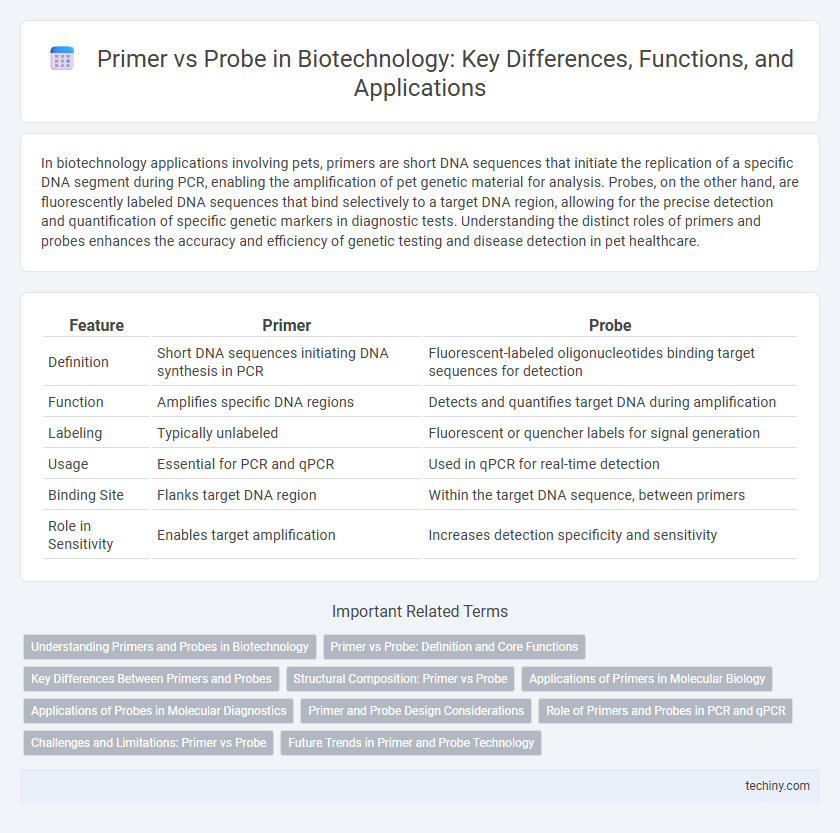In biotechnology applications involving pets, primers are short DNA sequences that initiate the replication of a specific DNA segment during PCR, enabling the amplification of pet genetic material for analysis. Probes, on the other hand, are fluorescently labeled DNA sequences that bind selectively to a target DNA region, allowing for the precise detection and quantification of specific genetic markers in diagnostic tests. Understanding the distinct roles of primers and probes enhances the accuracy and efficiency of genetic testing and disease detection in pet healthcare.
Table of Comparison
| Feature | Primer | Probe |
|---|---|---|
| Definition | Short DNA sequences initiating DNA synthesis in PCR | Fluorescent-labeled oligonucleotides binding target sequences for detection |
| Function | Amplifies specific DNA regions | Detects and quantifies target DNA during amplification |
| Labeling | Typically unlabeled | Fluorescent or quencher labels for signal generation |
| Usage | Essential for PCR and qPCR | Used in qPCR for real-time detection |
| Binding Site | Flanks target DNA region | Within the target DNA sequence, between primers |
| Role in Sensitivity | Enables target amplification | Increases detection specificity and sensitivity |
Understanding Primers and Probes in Biotechnology
Primers are short DNA sequences that initiate DNA synthesis during polymerase chain reaction (PCR), enabling DNA amplification by providing a starting point for DNA polymerase. Probes are fluorescently labeled oligonucleotides designed to hybridize to specific DNA or RNA sequences, allowing real-time detection and quantification in techniques such as qPCR. Understanding the distinct roles of primers and probes is crucial for optimizing assay sensitivity, specificity, and accuracy in molecular diagnostics and genetic research.
Primer vs Probe: Definition and Core Functions
Primers are short strands of nucleic acids that initiate DNA synthesis by providing a starting point for DNA polymerase during PCR amplification. Probes are labeled DNA or RNA sequences designed to hybridize specifically to a target sequence, enabling detection and quantification through fluorescence or other signals. While primers enable amplification of genetic material, probes serve as diagnostic tools for identifying and measuring specific nucleic acid sequences in biotechnology applications.
Key Differences Between Primers and Probes
Primers are short single-stranded DNA sequences that initiate DNA synthesis during PCR by binding to target regions, while probes are labeled oligonucleotides designed to hybridize specifically within the amplified sequence to enable detection. Primers serve as starting points for DNA polymerase extension, whereas probes provide fluorescence-based specificity for real-time monitoring and quantification in qPCR assays. Unlike primers, probes contain fluorescent reporters and quenchers that produce signal changes upon hybridization, enhancing assay sensitivity and specificity.
Structural Composition: Primer vs Probe
Primers are short single-stranded DNA sequences, typically 18-25 nucleotides long, designed to specifically bind to target DNA regions, enabling the initiation of DNA synthesis during PCR. Probes consist of oligonucleotides labeled with fluorescent reporters and quenchers, allowing real-time detection of target sequences through hybridization without extension. The structural composition of primers emphasizes binding and extension functionality, while probes integrate signaling elements for monitoring amplification processes.
Applications of Primers in Molecular Biology
Primers serve as essential starting points for DNA synthesis in techniques like PCR, enabling targeted amplification of specific genetic sequences. They facilitate applications such as gene cloning, mutation detection, and gene expression analysis by binding to complementary DNA strands. Primers also play a critical role in sequencing and genotyping, driving advances in molecular diagnostics and genomic research.
Applications of Probes in Molecular Diagnostics
Probes are essential in molecular diagnostics due to their high specificity in detecting target nucleic acid sequences, enabling accurate identification of pathogens and genetic mutations. Unlike primers, probes provide real-time monitoring of amplification processes in techniques such as qPCR, enhancing sensitivity and quantification accuracy. Applications include detecting infectious diseases, genetic disorders, and cancer biomarkers, facilitating early diagnosis and personalized treatment strategies.
Primer and Probe Design Considerations
Primer and probe design considerations in biotechnology centers on specificity, melting temperature (Tm), and GC content to ensure accurate target binding and amplification efficiency. Primers require balanced length, typically 18-25 nucleotides, with minimal secondary structures or dimers, while probes demand higher specificity and stability, often incorporating modifications like fluorescent reporters or quenchers. Optimal primer-probe pairing enhances sensitivity and reduces non-specific amplification in applications such as qPCR and genetic sequencing.
Role of Primers and Probes in PCR and qPCR
Primers in PCR and qPCR serve as short nucleotide sequences that initiate DNA synthesis by binding to specific target regions, enabling amplification of the desired DNA fragment. Probes are fluorescently labeled oligonucleotides that hybridize to the target sequence during qPCR, allowing real-time detection and quantification of amplified DNA through fluorescence signal generation. The combination of primers for amplification and probes for detection ensures high specificity and sensitivity in molecular assays.
Challenges and Limitations: Primer vs Probe
Primers face challenges in specificity, often leading to non-specific binding and false positives in PCR amplification, while probes offer higher specificity but can increase assay complexity and cost. Primer design limitations include difficulties in targeting regions with high GC content or secondary structures, whereas probes may suffer from reduced sensitivity if fluorescence quenching or signal interference occurs. Both components require precise optimization for reliable quantitative and qualitative analysis in molecular diagnostics and gene expression studies.
Future Trends in Primer and Probe Technology
Future trends in primer and probe technology in biotechnology emphasize the integration of digital PCR and CRISPR-based diagnostics to enhance sensitivity and specificity. Advances in machine learning algorithms enable the design of highly specific primers and probes, reducing off-target effects and improving assay accuracy. Emerging multiplexing techniques facilitate simultaneous detection of multiple targets, accelerating pathogen identification and genetic analysis in clinical and environmental applications.
Primer vs Probe Infographic

 techiny.com
techiny.com